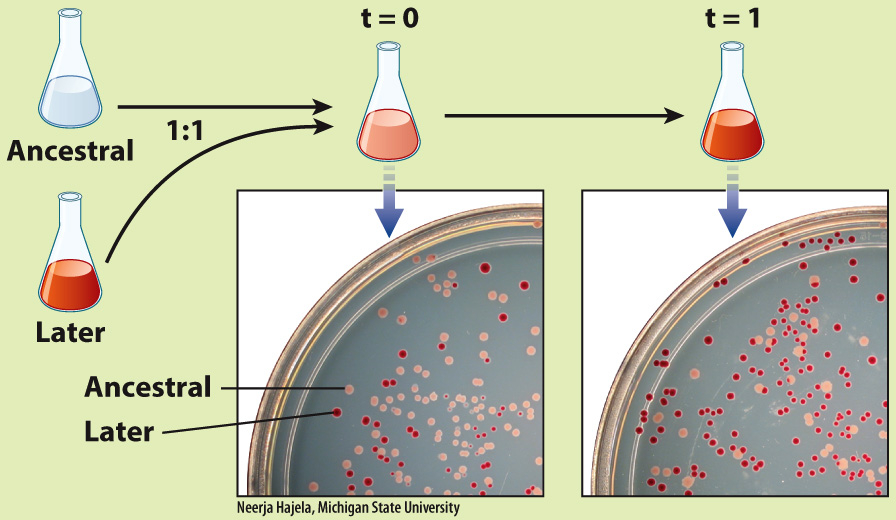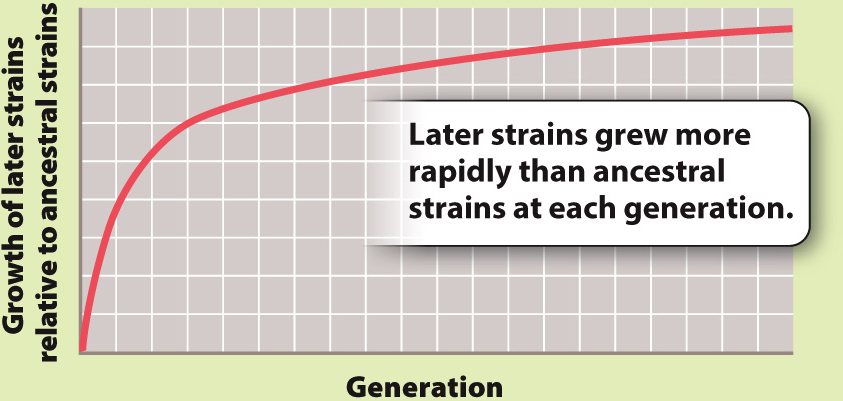Evolution can be studied by means of experiments.
Both the nested patterns of similarity among living organisms and the succession of fossils in the geologic record fit the predictions of evolutionary theory. Can we actually capture evolutionary processes in action? One way to accomplish this is in the laboratory. Bacteria are ideal for these experiments because they reproduce rapidly and can form populations with millions of individuals. Large population size means that mutations are likely to form in nearly every generation, even though the probability that any individual cell will acquire a mutation is small. (In contrast to bacteria, think about trying evolutionary experiments on elephants!)
One such experiment is illustrated in Fig. 1.18. The microbiologists Santiago Elena and Richard Lenski grew populations of the common intestinal bacterium Escherichia coli in liquid medium, with the organic acid succinate as the only source of food. In general, E. coli cells feed on succinate poorly if at all, leading the researchers to hypothesize that any bacterium with a mutation that increased its ability to use succinate would reproduce at a faster rate than other bacteria in the population. The key questions were: Did bacteria from later generations differ from those of earlier generations—
In fact, the bacteria did evolve an improved ability to use succinate, demonstrated by the results shown in Fig. 1.18. This experiment illustrates how experiments can be used to test hypotheses and it shows evolution in action. Furthermore, follow-
HOW DO WE KNOW?
FIG. 1.18
Can evolution be demonstrated in the laboratory?
BACKGROUND Escherichia coli is an intestinal bacterium commonly used in the laboratory. It grows poorly in liquid media where the only source of food is succinate. Santiago Elena and Richard Lenski wondered whether E. coli grown for 20,000 generations in succinate would evolve in ways that improved their ability to metabolize this compound.
HYPOTHESIS Any bacterium with a random mutation that increases its ability to utilize succinate will reproduce at a faster rate than other bacteria in the population. Over time, such a mutant will increase in frequency relative to other types of bacteria, thereby demonstrating evolution in a bacterial population.
EXPERIMENT Cells of E. coli can be frozen in liquid nitrogen, which keeps them in a sort of suspended animation in which no biological processes take place, but the cells survive. At the beginning of the experiment, the researchers froze a large number of samples of the starting bacteria (“Ancestral”). As the experiment progressed, they took samples of the bacterial populations at intervals (“Later”) and grew them together with a thawed sample of the starting bacteria in succinate. They then compared the rate of growth of the ancestral bacteria with that of the bacteria taken at later time points.
RESULTS At each time interval, the cells from later time points grew more rapidly than the ancestral cells when the two populations were grown together in succinate.

Over time, the bacteria grown in succinate showed more and more improvement in growth compared to the starting bacteria.

CONCLUSION Evolution occurred in the population: The bacteria evolved an improved ability to metabolize succinate.
FOLLOW-
SOURCE (top) Elena, S. F., and R. E. Lenski. 2003. “Evolution Experiments with Microorganisms.” Nature Review Genetics 4:457–
Experiments in laboratory evolution help us to understand how life works, and they have an immensely important practical side as well. They allow biologists to develop new and beneficial strains of microorganisms that, for example, remove toxins from lakes and rivers. And they show how some of our worst pathogens develop resistance to drugs designed to eliminate them.
Quick Check 4 How might the heavy-
Quick Check 4 Answer
The use of antibiotics selects for antibiotic resistance among bacteria. Bacteria do not become antibiotic resistant out of “need” or because resistance would be advantageous for them. Instead, before the application of antibiotics, bacteria with antibiotic resistance exist in low numbers. The application of antibiotics allows these bacteria to grow and reproduce more successfully than those that are susceptible to antibiotics. Mutations, such as those responsible for antibiotic resistance, are not influenced by whether or not the organism is in an environment in which that mutation would be advantageous.